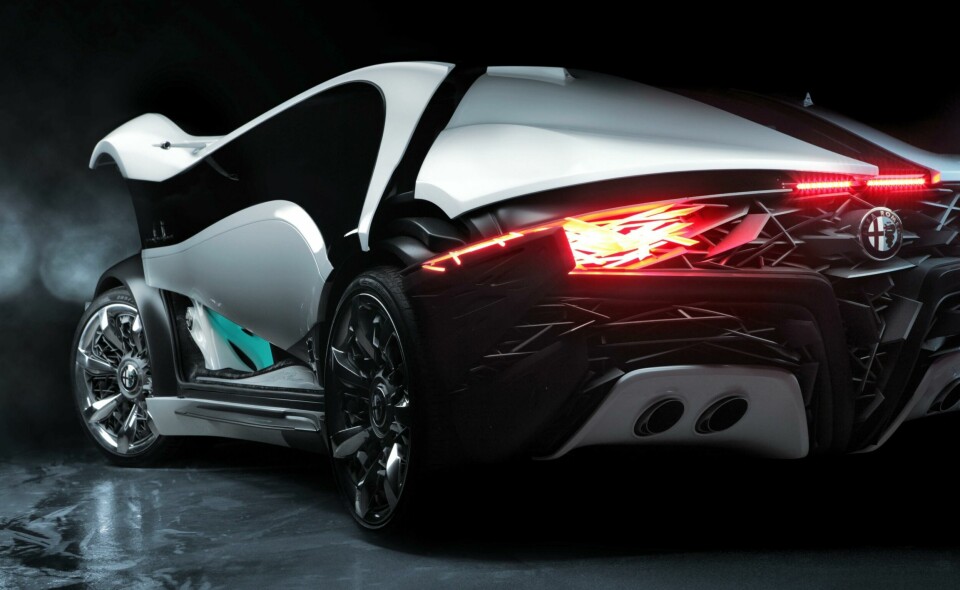
CCotW: Bertone Pandion (2010)
A highly dramatic return to Geneva for Bertone, mixing sci-fi and high-tech with hawks and helmets
The 2018 Geneva International Motor Show wraps up this weekend, and before the cars and stands are packed off and Palexpo repurposed for the next big trade show, we thought we would revisit a striking concept car that debuted at the Geneva Show at the start of this decade: the Bertone Pandion.

A dramatic return to Geneva for Bertone
The concept marked the return of Bertone in 2010 to Geneva after a two year absence. It was also Design and Brand Director Michael Robinson’s first concept car for the storied carrozzeria, built to celebrate the centenary of Alfa Romeo’s birth.

The Pandion was named for the Osprey. Note the black/white markings on the head
The name ‘Pandion’ referred to the Greek name Pandion haliaetus, which is the species name of a bird of prey common in almost all seashore areas of the world. It is known by various names including Osprey, Seahawk, River Hawk and Fish Hawk.
Bertone noted that the dramatic wings and distinct black and white facial markings strongly influenced the design of the car, including the mask at the front.

Ribbons of steel and glass stretched over a structural frame
The Pandion’s organizing principle was the ‘Skin and Frame’ concept. A structural frame starting at the grille, wrapping around the passenger compartment and completing itself at the rear of the car, was the armature for a taut skin and glazing that wrapped itself over the frame.

Classic sports car proportions and dramatic graphics
The overall form is pure sports car; a long nose, a cab-rearward architecture and fastback tail. Sharp-eyed Bertone fans will note the curvature of the roof closely approximates that of the Bertone Birusa of a few years prior.

The front mask reminded many of the great helms of the Middle Ages
At the front the scowling mask recalls medieval helmets, a reference to Turin’s armor crafting past (The Fiat Barchetta concept of 2007 recalls this history even more directly). At the centre of the mask were the five bars of Alfa Romeo’s grille, with quad headlights deeply recessed in the outer corners of the mask.

Alfa badge centers the seemingly random ‘pixelated’ elements
At the rear, the car is a pixelated composition of elements, with a dramatic array of intertwining black blades across the rear fascia. At the taillights, the colour changes to yellow/orange/red, like flames shooting out from the car.
Bertone described the effect as like that of a comet with a sleek body that “dematerializes” into a long tail.

The side glass made a very strong graphic statement and kept the eye flowing across the flanks of the car
Linking the front and rear along the flanks of the car were the long doors and their extensive side glass. It made for quite a graphic statement and combined with the roof glazing crated a ribbon effect of glass and body. The overall graphic effect was one of the strongest in any concept car in many years.

Dramatic doors celebrated entry into the Pandion cockpit
The interior was accessed through two dramatic scissor doors each three metres in length. Hinged over the rear wheels, these doors, which extended to the front wheels, made for quite a dramatic entry sequence and recalled similar doors in the Alfa Romeo Carabo and the ’07 Fiat Barchetta concept. When fully open, the doors stood some 3.6 metres high.
Bertone’s Press Release noted that “This spectacular solution is designed mainly for glamour, bringing back the “wow” factor to today’s lacklustre automotive industry.”
The press release went on to note that as vertical access to the interior was limited, a longer horizontal opening aided ingress and egress.

Pandion interior – glowing seats and an organic frame gave it a sci-fi feel
Once seated inside, one noticed the skeletal frame that was a centerpiece of the interior. Although an exposed frame is nothing unusual in a sports or race car, the irregular “algorithmic” design of the frame struck some as perhaps too organic, too tentacle-like.

The seats – incredibly thin and glowing blue
The seating was 2+2, with the front seats composed of carbonfibre shells covered with Technogel® and backlit with reLIGHT® fabric, all in a 30mm construction.

Instrumentation, augmented by four flat screens
In front of the driver is an array of instrumentation, augmented by four flat screens that allow views of the interior and exterior as well as controls for infotainment.
Reception at the Geneva Show was mixed. Some loved the classic sports car shape mixed with bold graphics, dramatic doors and science fiction interior. Others hated it for much the same reasons. Some dismissed it as looking like a sneaker. Others noted the front mask looked like Boba Fett, of Star Wars fame (it did).

Pandion revealed at Geneva – space aliens in attendance…
But the Pandion received a mostly warm reception from the press, which welcomed the return of Bertone and its dramatic design statement.
The Pandion, even in Bertone’s press release, was described as a “dream car”. It was a demonstration of Bertone’s design and engineering capabilities. There were never any plans for production. It remains a dream car, and a sort of swansong for Bertone, which would be gone in less than five years.





